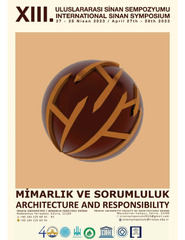Приказ основних података о документу
User-perception of living heritage in contemporary city: Social, contextual and historical responsibility
| dc.creator | Spasenović, Vanja | |
| dc.date.accessioned | 2023-11-13T19:42:03Z | |
| dc.date.available | 2023-11-13T19:42:03Z | |
| dc.date.issued | 2023 | |
| dc.identifier.isbn | 978-975-374-359-4 | |
| dc.identifier.uri | https://raf.arh.bg.ac.rs/handle/123456789/1457 | |
| dc.description.abstract | Research within this paper examines the concept of visual responsibility of the contemporary city towards cultural heritage. The legacy of the 20th century, seen as living heritage, is specifically highlighted as problematic concerning the frequent failure to recognize architecture from this period as a member of cultural heritage. These built structures require complex conservation methodologies in order to adapt to contemporary building standards in pursuance of inclusion in the daily life of the city. Subject importance is recognized through the intensive interdisciplinary discussion about different methodologies of XX century heritage conservation, which results in new global initiatives, documents and movements. Contemporary initiatives predominantly focus on the restoration of technical and technological aspects of the objects, while less attention falls on the life of heritage in the everyday context, as well as the observer's contact with these spaces. Considering that the recognizability of the heritage from this period has already been marked as problematic in scientific circles, this paper examines the potential for the instrumentalization of perception of the built structure in user’s everyday contact with its surroundings. If the users perceive the environment as architecturally, environmentally or historically significant, they identify with the analyzed space, which represents the first step in its potential preservation and conservation. The hypothesis within this paper is that the perception of heritage in the immediate environment, defined through the intensity and quality of the user's perception, has a significant role in understanding the way heritage lives in the modern city. In this way, special importance is given to the sociological, contextual and architectural determinants of space. Research result is the definition of methodology for the visual valorization of heritage in city context, as well as the impact of potential future interventions on its perceptual quality, defined in this paper as visual responsibility. The methodology will be set through a case study of New Belgrade, seen as a representative of modernist architecture of the 20th century that still lives in the contemporary context of the Serbia’s capital. | sr |
| dc.language.iso | en | sr |
| dc.publisher | Edirne : Trakya University, Faculty of Architecture | sr |
| dc.rights | openAccess | sr |
| dc.source | Proceedings of the XIII International Sinan Symposium ARCHITECTURE AND RESPONSIBILTY, Trakya University, Edirne, Turkey (April 27-28th 2023) | sr |
| dc.subject | Cultural heritage | sr |
| dc.subject | Spatial cognition | sr |
| dc.subject | Identity | sr |
| dc.subject | Visual interpretation | sr |
| dc.subject | Emerging heritage | sr |
| dc.title | User-perception of living heritage in contemporary city: Social, contextual and historical responsibility | sr |
| dc.type | conferenceObject | sr |
| dc.rights.license | ARR | sr |
| dcterms.abstract | Спасеновић, Вања; | |
| dc.citation.spage | 384 | |
| dc.citation.epage | 392 | |
| dc.identifier.fulltext | http://raf.arh.bg.ac.rs/bitstream/id/5013/bitstream_5013.pdf | |
| dc.identifier.rcub | https://hdl.handle.net/21.15107/rcub_raf_1457 | |
| dc.type.version | publishedVersion | sr |

